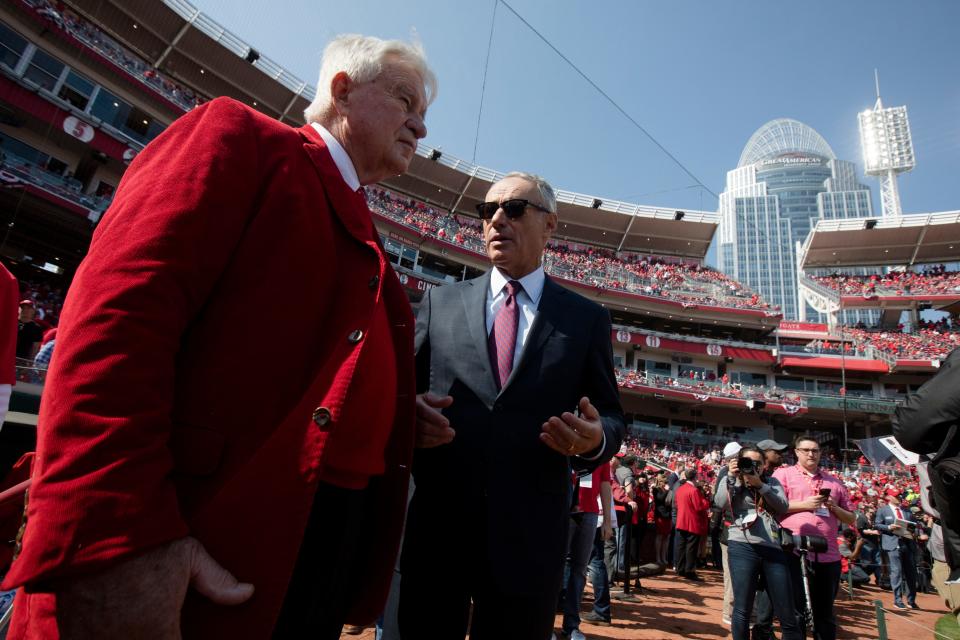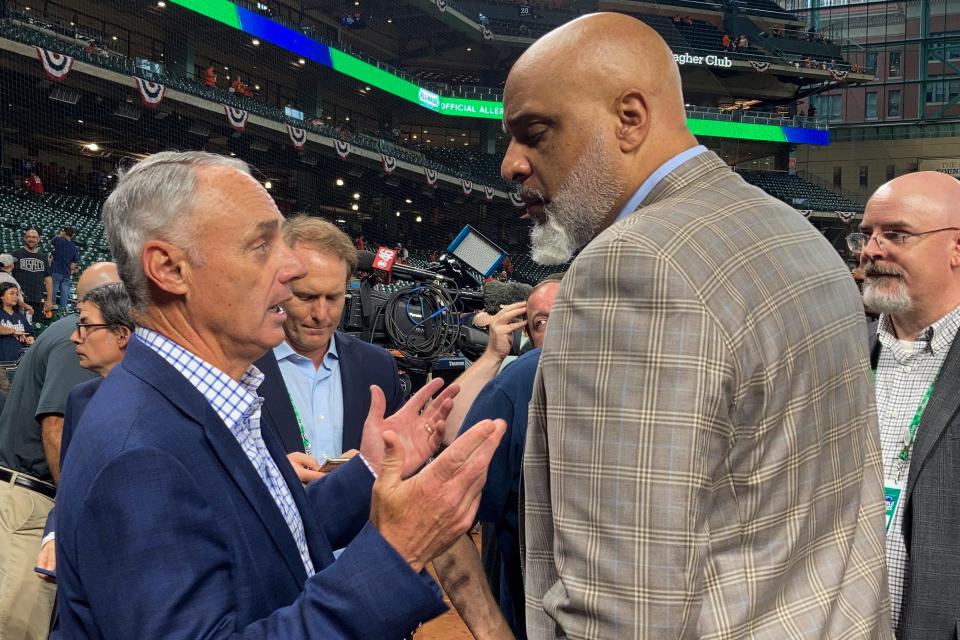Major League Baseball could have a work stoppage on December 2: Here's what we know now.
Major League Baseball is on the verge of its first work stoppage since a strike canceled the 1994 World Series, which will likely put a pause on all offseason activities.
The sport’s collective bargaining agreement expires at 11:59 p.m. on Dec. 1 and the expectation is the owners will immediately lock out the players. An offseason lockout would freeze all transactions on Major League rosters until new rules are in place and likely force the cancellation of the annual Winter Meetings (except the minor-league portion).
The length of a potential lockout is unknown. The faster it’s resolved, the less it’s a threat to disrupt the 2022 season. Spring training is set to begin in the middle of February and the regular season is scheduled to start on March 31.

“We’ve been down this path,” MLB commissioner Rob Manfred told reporters from the owner’s meetings in Chicago last week. “We locked out in ’89-’90. I don’t think ’94 worked out too great for anybody. I think when you look at other sports, the pattern has become to control the timing of the labor dispute and try to minimize the prospect of actual disruption of the season. That’s what it’s about. It’s avoiding doing damage to the season.”
What happens in a lockout?
All Major League activity is frozen. No trades involving players on the 40-man roster. No free-agent signings. Players are not permitted to work out at team facilities. Players who are rehabbing injuries may be forced to move to a non-team facility.
The minor leagues, which are not a part of the players union or the collective bargaining agreement, will move along as normal.
What are the core issues between owners and players?

There are a lot of issues for the owners and players association to solve, as evidenced by the ugly feud that played out publicly last year when the two sides were negotiating how to pay players for the pandemic-shortened season.
Four issues, however, seem to be at the forefront of the talks:
Incentives to tank? It’s become more of a have and have-not league. Four teams lost 100 games last season. Two more teams lost at least 95 games. Payroll disparities often highlight the difference between contenders and rebuilders (Dodgers carried a payroll above $260 million this year and the Pirates were at $50 million), and the league reportedly proposed a salary floor. A large chunk of Major League players come from the first 60 picks in the draft, so there is a lot of value from receiving top picks.
Service time manipulation: It’s not beneficial to the sport when the best young players are kept in the minor leagues so teams can retain an extra year of control before they reach free agency. No other major sport has the same issue with their young stars.
Paying young players earlier in their careers: The current model for Major League players is they make near the minimum for the first three years, they’re eligible for arbitration for the next three years and then they reach free agency. Teams value younger players because they’re cheaper and under team control for longer. The league made a proposal tying WAR (wins above replacement) calculations to pay players instead of the arbitration system and proposed making players eligible for free agency at 29 ½ years old, according to the Athletic.
Finding more value from free agency: The mean salary from MLB’s 125 highest-paid players dipped from $18.9 million in 2020 to $18.4 million in 2021. The league’s luxury tax has essentially turned into a salary cap for most teams. Qualifying offers, which are often attached to top free agents, could be modified.
What are the major on-field changes?
It’s widely expected there will be a universal designated hitter implemented for next season, so pitchers will no longer hit in the National League. Pitchers collectively hit .110 last season while designated hitters hit a combined .239.
The playoffs will likely expand – ESPN already acquired the TV rights to the additional postseason round. It could be seven teams per league (three division winners and four wild cards) with a best-of-three series in the first round of the postseason, though the league had eight teams per league (three division winners, three second-place teams and two wild cards) during the pandemic-shortened 2020 season.
Manfred, at the All-Star Game, said seven-inning doubleheaders and the runner at second base to begin extra innings were unlikely to remain in place.
The league is experimenting with tackier baseballs, which provide a better grip, after foreign substances became pervasive among pitchers. The implementation of a pitch clock has been successful at some levels and could work its way to the Majors.
Changes that could happen in the future, but not immediately, include restrictions on defensive shifts and an automatic strike zone. It’s unclear if limiting shifts would have a dramatic effect on balls in play. Automatic strike zone technology is still a work in progress.
Could the lockout disrupt the regular season?
Stay tuned.
This article originally appeared on Cincinnati Enquirer: MLB near work stoppage, lockout over collective bargaining agreement

